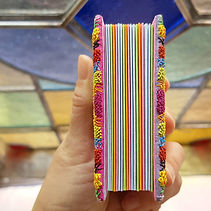Details about the binding by Hannah Brown:

ABOUT THE BINDING:
• The book is bound in pink and lilac pigskin with a black goatskin spine.
• The covers of the book are embroidered in concentric circles, with each section containing a different coloured thread and stitches.
• The binding has a false round spine, made from a half-round wooden dowel.
• The title of the book is embroidered using a coloured gradient of green threads.
• The areas covered in black goatskin are blind tooled using a small gouge.
• The doublures are made from bright pink and lilac crepe paper to match the paper flowers the book is displayed with.
• The text block is a long concertina, with coloured strips of crepe paper stuck to the outer folds so they are visible when the book is closed.
• The front and back of the concertinaed text block are glued into the boards.
• The binding is housed under a glass cloche that sits on a painted wooden base.
• Under the cloche sits the book alongside three crepe paper flowers, all made from hand: an orange carnation, a white cosmos and a pink zinnia
• The flowers can be slid in and out of brass tubes that are glued into the wooden base.



DESCRIPTION OF DESIGN:
The design of this book includes a glass cloche, under which the book and three crepe paper flowers sit together.
A cloche (from French, cloche for “bell”) is a covering for protecting plants from cold temperatures. The original form of a cloche is a bell-shaped glass cover that is placed over an individual plant, acting like a mini greenhouse in the garden. The use of cloches is traced back market gardens in 19th century France, where entire fields of plants would be protected with cloches to offer frost protection to small plants and relief to newly planted seedlings trying to develop adequate root systems.
In the 19th century, glass cloches were mainly used by naturalists as tiny “curiosity cabinets”, to showcase collectors delicate finds such as insects, plants or small taxidermic animals.




Given this book contains many beautiful images of flowers, I wanted to try my hand at making my own crepe paper flowers to go with the binding. I thought that a cloche would make a very suitable container for the book and these flowers, and due to the miniature size of the book would help give the appearance of it as part of a prized collection of objects.
We see circles all around us in nature, including in planets, stars, tree rings, rain drops and flowers. I therefore chose to use concentric circles for the cover design to convey this. Each ring contains a different type of stitch made using different colours of thread. The stitches are built up to look like different flower stamens, inspired in colour by the flower pictures in the book.






